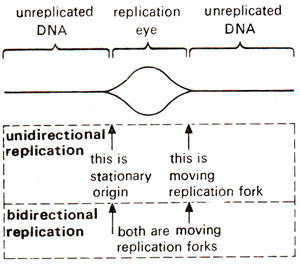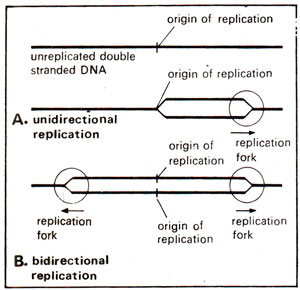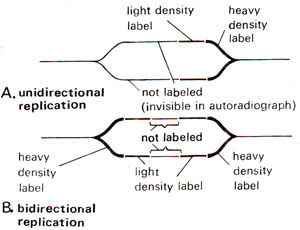Unidirectional and bidirectional DNA replication

Fig. 26.8. A diagrammatic representation of an electron micrograph of replicating eukaryotic DNA, showing formation of 'bubble' or 'eye'.

Fig. 26.9. A replication eye may represent unidirectional replication (when only one end moves) or a bidirectional replication (when both ends move).

Fig. 26.10. The difference between unidirectional and bidirectional replications in the movement of replication forks.

Fig. 26.11. Distinction between unidirectional and bidirectional replication as revelead by radioactive labelling (note increasing densities of labelling on only one side or on both the sides of origin of replication).
In view of the above evidences, it is now known that DNA replication can be unidirectional or bidirectional, depending upon whether the replication from the point of origin proceeds only in one direction or proceeds in both the directions, (Fig. 26.9, 26.10). A replication eye may appear in both the situations, unless the replication starts from one of the two ends of a linear DNA molecule. However, in unidirectional replication, one of the two ends of the replication eye will be stationary and the other end will move with replication (Fig. 26.9). On the other hand, in bidirectional replication, none of the two ends will be stationary and both will be moving (Fig. 26.10). If radioactively labelled nucleotides are used during DNA synthesis, distinction between unidirectional and bidirectional replication can be made by the study of autoradiographs prepared after DNA synthesis has already proceeded for some time with the use of labelled nucleotides. Labelling on both the replication forks will indicate bidirectional replication and labelling only at one fork will suggest unidirectional replication (Fig. 26.11). An example of unidirectional replication is the replication of niitochondrial DNA (mtDNA) by D-loops in vertebrates (seeMaternal Effects and Cytoplasmic Inheritance).

Fig. 26.8. A diagrammatic representation of an electron micrograph of replicating eukaryotic DNA, showing formation of 'bubble' or 'eye'.

Fig. 26.9. A replication eye may represent unidirectional replication (when only one end moves) or a bidirectional replication (when both ends move).

Fig. 26.10. The difference between unidirectional and bidirectional replications in the movement of replication forks.

Fig. 26.11. Distinction between unidirectional and bidirectional replication as revelead by radioactive labelling (note increasing densities of labelling on only one side or on both the sides of origin of replication).




